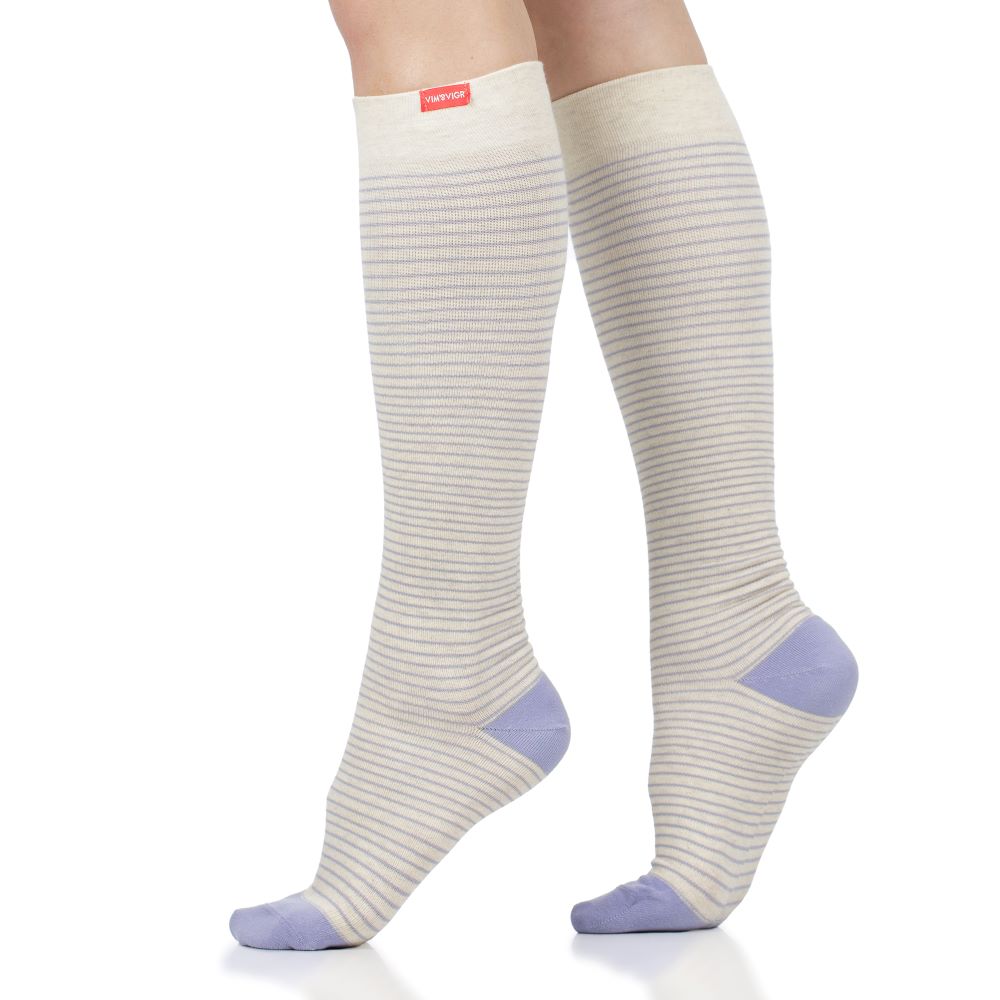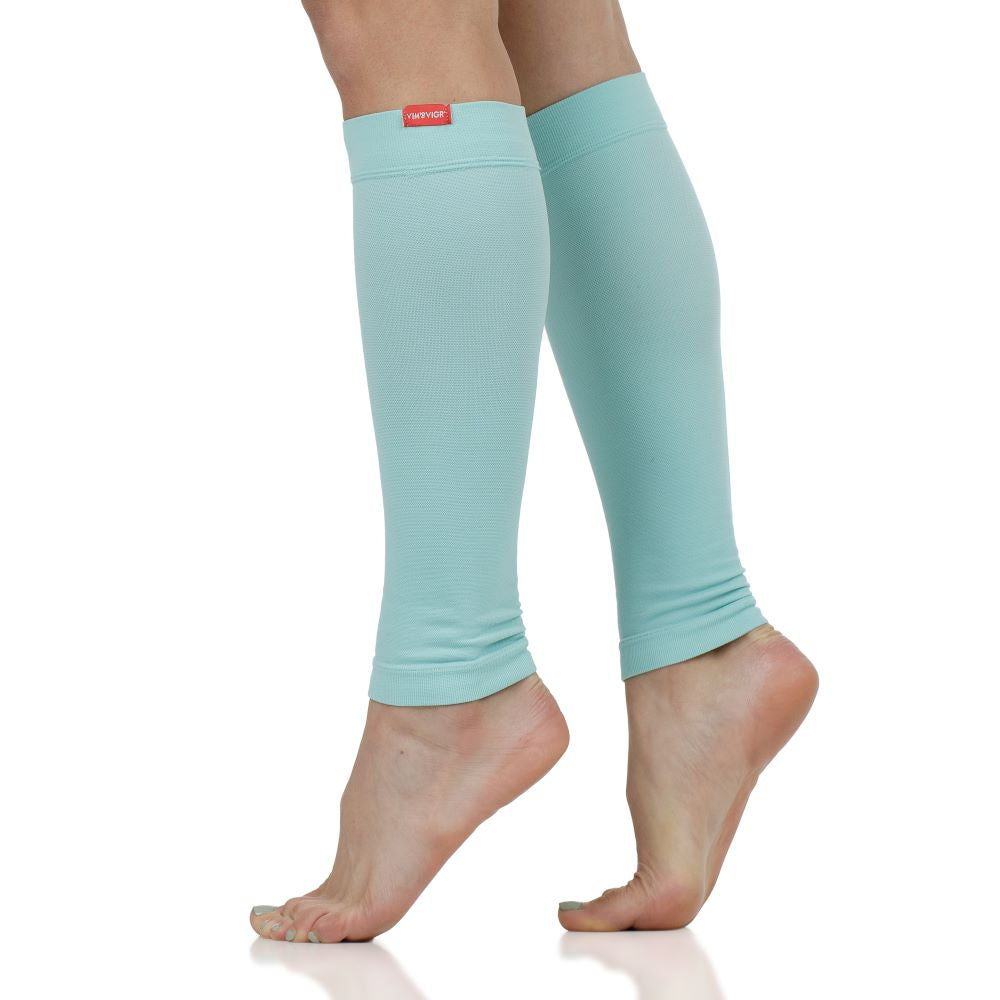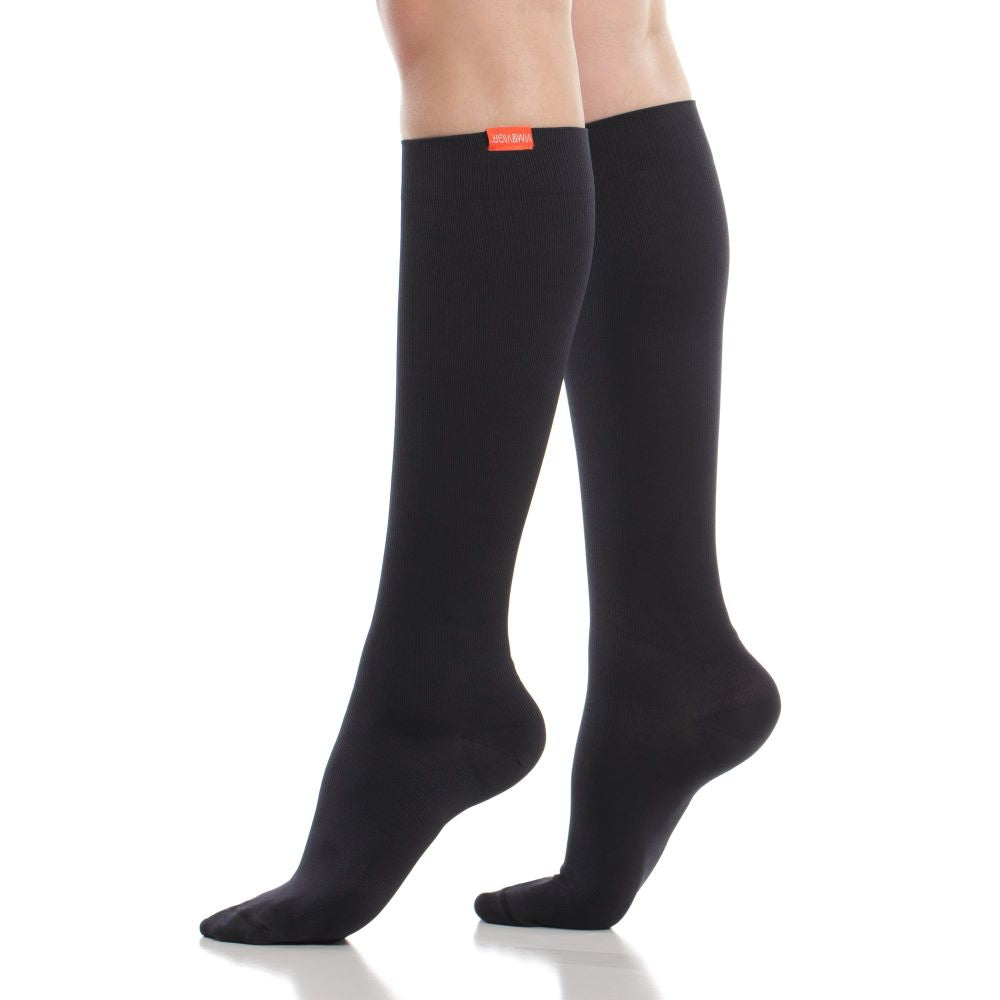Ted Hose vs Compression Stockings: What's the Difference?
If you have struggled with swelling or even blood clots in your legs, you have probably heard of TED hose. “TED” stands for thromboembolic deterrent, which basically means blood clot prevention. TED hose are also recommended to people after surgery for reducing swelling and are known to prevent issues with blood clots or fluid circulation. Therapeutic compression applied to the legs is often recommended if you are immobilized and spend most of your day lying in bed. As an alternative to TED hose, doctors may prescribe graduated medical compression stockings, which people often confuse with TED hose.
The truth is that either might be the right choice for you, but choosing TED hose vs. compression stockings or socks depends on your situation and your doctor’s recommendation. This article will take a deep dive into the differences between TED Hose and compression stockings are, and the highlights are as follows:
- Compression socks are great for everyday wear, and can come in stylish varieties to match your style. Compression socks come in compression levels starting at 15-20 mmHg, and often can be in pressures ranging all the way to 40-50 mmHg.
- TED hose are used for immobilized or bedridden patients. They come in lower grade compression, typically 8-18 mmHg, because they are prescribed for post-surgical use on patients who will be lying flat. Since people wearing TED hose won’t be walking, standing, or sitting for prolonged periods of time, blood won’t be pooling in the ankles as much, so a lighter compression is effective.
Want to learn more? Keep reading! Want to try compression socks? Check out our stylish options offered in 15-20 mmHg, 20-30 mmHg, and 30-40 mmHg.

What’s the difference between compression socks and TED Hose?
In short, both are compression garments that support healthy circulation, but their general applications differ. TED hose stockings are usually used immediately following surgery to support healthy circulation in the legs and prevent blood clots. Compression socks have broader application and may be worn everyday preventatively. Compression socks and stockings are often used daily by people with chronic venous insufficiency, to prevent blood clots (especially when flying), and to improve exercise performance or recovery.
In this blog we will cover all you need to know about TED Hose vs Compression socks, and when each is the appropriate choice to support healthy circulation and to prevent health problems like blood clots or deep vein thrombosis.

What to know about Ted Hose
TED hose are a type of stocking specifically designed to prevent blood clots and swelling in your legs. There are similarities between TED hose and compression socks regarding how they work (applying pressure but at different pressures), and both can be worn to prevent blood clotting. But are TED hose the same as compression socks or stockings? In short, no, and below explains why.
Purpose
Also known as anti-embolism stockings, the term “TED hose” stands for “thromboembolic deterrent hose” – the medical term used in the professional world. They are specifically designed to apply pressure to blood vessels in the legs to prevent the formation of blood clots.
The main purpose of TED hose is to prevent blood clots or embolism in non-mobile persons or bedridden post-surgery patients. TED hose help prevent blood clots or thrombotic events by applying pressure to improve blood flow in the legs. Research has found that compression following surgery is effective for preventing blood clots.
Doctors use TED hose for people who are bedridden or mobility impaired, and this is one of the big differences between them and compression socks or stockings. TED hose usually leave the toes free, and you are not expected to walk around while wearing TED hose. On the other hand, compression socks or stockings have a range of pressure levels and are designed to be worn all day while walking, sitting, or standing. This helps people manage venous conditions as well as avoid discomfort or pain from swollen legs and feet from standing, walking, or sitting without moving for too long.
Compression Level
The pressure applied by compression clothing is measured in mmHg (millimeters of mercury), the higher the number, the higher the pressure. For TED hose, pressure applied on the leg is actually the lightest level, with a compression level of 8-18 mmHg.
Since TED hose are used for those who are non – mobile, the compression is lighter since the patient is not on their feet. But because the legs can still swell while laying down, light compression supports healthy circulation while preventing fluid buildup, which is what helps prevent blood clots.
Duration of Use
Doctors prescribe TED hose to post-surgery patients and it’s usually a medical process to get them, unlike in the case of compression stockings. Patients use TED hose for short-term recovery periods, up to a maximum of three weeks after surgery. As soon as patients can start to walk and do other forms of exercise, they will need a different type of compression therapy to support their circulation needs. This is when you should switch to compression socks or stockings.
Design
TED Hose is not used for stylish wear, so like many other medical items they only come in beige, black, or white. Since patients are not typically walking this is fine for recovery, however for those who want stylish designs while still getting health benefits from compression, compression socks or compression stockings are the way to go.
What to Know About Compression Socks
Beyond their intended use, TED hose differ from compression stockings in their design, the length of time they should be worn for, and the level of pressure they delivers. Here are the key differences between the two products.
Purpose
Compression socks and stockings can be worn on a casual basis, for example during a long airplane flight or even for an entire day at a time. It’s normally recommended to wear compression garments daily. Compression socks utilize graduated compression to gently hug the lower leg tightest at the ankle and circulate blood all day. Compression stockings apply this pressure to the whole leg. So, depending on your needs and comfort, either will give you the therapeutic pressure you need to get a variety of benefits.
Graduated compression prevents blood from pooling in the ankles and legs and improves blood flow. Compression therapy has been around for hundreds of years and helped countless people to live in comfort. Clinical research studies have found that compression with socks or other devices may provide health benefits including:
- Reduced Swelling to prevent edema, blood clots, or other thrombotic events
- Reduced Aches and Pains
- Increased Muscle Recovery
- Improved Exercise Performance
- Better Sleep for People with Restless Leg Syndrome
- Improved Leg Circulation
- Prevent or Manage Varicose Veins
- Increased energy
Compression Level
Compression socks pressures generally start from 15-20 mmHg (over the counter) and can go up to 40-50 mmHg (medical class). Depending on your situation, consider discussing a prescription for higher-level compression socks. It’s worth noting that firm compression isn’t for everyone (depending on your health concerns).
Be sure to consult your medical provider before using compression socks or stockings, especially if you have problems with your heart or blood vessels.
Design
As mentioned above, TED hose usually have open toes and are available as a knee-high or thigh-high sock. There is an inspection access point by which doctors can check the patient’s blood circulation at the toes. Because they’re not meant for walking around in, TED stockings may slide down your legs and/or bunch up, even when moving around in a hospital bed.
Conversely, compression socks give you the health benefits of therapeutic compression while also being a stylish fashion item, available in many colors and styles. The large majority are not prescription-based medical items, and compression socks or stockings can be easily bought online or over the counter. They can be higher or lower rise, and you may also find sleeves and footless designs. Within the general category of compression socks, there are also graduated compression stockings. Graduated compression applies pressure at the ankle and slowly releases pressure up the leg, which has been found to improve blood flow by this research study.
Duration of use
Compression socks can be worn all day every day. Some people wear compression socks 24 hours a day and are still comfortable. Since compression socks are used preventatively, they can be worn as much or as little as you would like. Many people enjoy the benefits of wearing compression stockings or compression socks without the prescription of a doctor. If you wear your compression socks often, replacing them is important. If worn every day, compression socks will need to be replaced every 6 months.
Who Should Choose TED Hose?
“TEDs are for beds” is a common quote to describe the use of TED hose. As we have covered previously, bedridden or mobility impaired patients use TED hose.
TED hose can be used successfully to prevent blood clotting in patients recovering from surgery or otherwise bedridden, who are not able to ensure proper blood flow to their legs and feet by walking and changing positions daily. As you recover, compression socks can be a great tool for continued support and a boost in circulation for everyday wear.
Who Should Choose Compression Stockings?
Compression socks have a much wider application than TED Hose. Compression socks range in compression level, fabric, and usage, making them more suitable for everyday wear. Anyone can benefit from compression socks. While many individuals with chronic illness or circulation issues benefit, runners, hikers, nurses, and travelers also like to wear compression socks. This is because compression socks drastically decrease the risk of DVT, blood clots, and leave your legs feeling fresh after exertion.
Ready to try compression socks? Learn more about how graduated compression can benefit you!

FAQs about TED hose:
Can TED hose cause bruising?
TED hose are most often applied in a medical setting and will exert a lighter level of pressure than compression garments, which should prevent any bruising or other such side effects from developing. However, if TED hose are not appropriately worn (one study found this happens in about 20% of people), they can cause issues like bruising, skin irritation or breakage, or even increase the risk of thromboembolism.
Why wear TED hose after surgery?
The main reason to wear TED hose is to prevent embolism (blood clots) for non-mobile persons. Therefore, if you’ve had any form of surgery which leaves you bedridden for a longer period of time, it’s a good idea to wear TED hose to make up for the lack of movement which would ensure correct blood flow to your legs and feet. Doctors will normally prescribe TED hose proactively, but do not hesitate to ask about it if you feel it might be necessary.
How to put on TED hose
Putting on TED hose is similar to putting on compression socks, but can be a little more tricky. If you do it yourself, the best way to put them on is to lie down with your legs propped on pillows for around 15 minutes beforehand. This way your blood will flow away from the legs and allow them to be less swollen. You should also apply some powder to your ankles to help ease the hose onto your legs.
Then, pull the stocking over your foot and pool it around your ankle, then use short, quick pulls to bring it all the way up your leg. Make sure it is applied evenly and is not bunching up anywhere.
Can I Wear Compression Socks Every Day?
Absolutely! You can wear compression socks all day, every day. They are meant to be worn during your everyday life. That is why we designed stylish compression socks that come in 4 functional fabrics, so you can find compression that suits you!
Our socks come in 15-20 mmHg, 20-30mmHg, and 30-40 mmHg and 6 different sizes, including wide calf varieties!
References
Bowling, K., Ratcliffe, C., Townsend, J., & Kirkpatrick, U. (2015). Clinical thromboembolic detterrent stockings application: are thromboembolic detterrent stockings in practice matching manufacturers application guidelines. Phlebology, 30(3), 200–203. Read it here.
Motykie, G. D., Caprini, J. A., Arcelus, J. I., Reyna, J. J., Overom, E., & Mokhtee, D. (1999). Evaluation of therapeutic compression stockings in the treatment of chronic venous insufficiency. Dermatologic surgery: official publication for American Society for Dermatologic Surgery [et al.], 25(2), 116–120. Read it here.
Clarke, M. J., Broderick, C., Hopewell, S., Juszczak, E., & Eisinga, A. (2021). Compression stockings for preventing deep vein thrombosis in airline passengers. The Cochrane database of systematic reviews, 4(4), CD004002. Read it here.
Mota, G. R., Simim, M. A. M., Dos Santos, I. A., Sasaki, J. E., & Marocolo, M. (2020). Effects of Wearing Compression Stockings on Exercise Performance and Associated Indicators: A Systematic Review. Open access journal of sports medicine, 11, 29–42. Read it here.
Tan, B., Xiao, C., Cheng, M., Zhu, Z., Liao, F., Lu, B., Yuan, J., Wei, D., Lv, B., Zhu, J., Huang, C., Tang, X., & Hu, J. (2021). A systematic review and meta-analysis of elastic stockings for prevention of thrombosis after orthopedic surgery. Annals of palliative medicine, 10(10), 10467–10474. Read it here.
Charles, T., Mackintosh, D., Healy, B., Perrin, K., Weatherall, M., & Beasley, R. (2011). Merino wool graduated compression stocking increases lower limb venous blood flow: a randomized controlled trial. Advances in therapy, 28(3), 227–237. Read it here.
Partsch, H., Winiger, J., & Lun, B. (2004). Compression stockings reduce occupational leg swelling. Dermatologic surgery : official publication for American Society for Dermatologic Surgery [et al.], 30(5), 737–743. Read it here.
Tan, M., Urbanek, T., Rabe, E., Gianesini, S., Parsi, K., Davies, A. H., & UIP (2024). Compression therapy in the management of varicose veins. Phlebology, 39(4), 276–279. Read it here.
Lettieri, C. J., & Eliasson, A. H. (2009). Pneumatic compression devices are an effective therapy for restless legs syndrome: a prospective, randomized, double-blinded, sham-controlled trial. Chest, 135(1), 74–80. Read it here.


















Very detailed and very easy to read. I now know the exacty difference between Ted and Compression. This article has equipped me with making the correct purchases. Currently I am wearing Ted, but seems that I actually need Compression. Thank you and I will recommend this blog/article to others
Very good and easy to read article. I was looking for this information and you are the only one who made it so clear and easy. Thank you.
I’m recovering from surgery with lots of swelling in feet, calves and thighs. I’m wearing thigh high TED hose as recommended by doctor. I’m beginning to walk with walker. TEDS roll down and pinch my thighs. I was hoping you might have pantyhose TED stockings to prevent rolling of thigh highs.
In need of knee high compression socks for wide calves.
Leave a comment